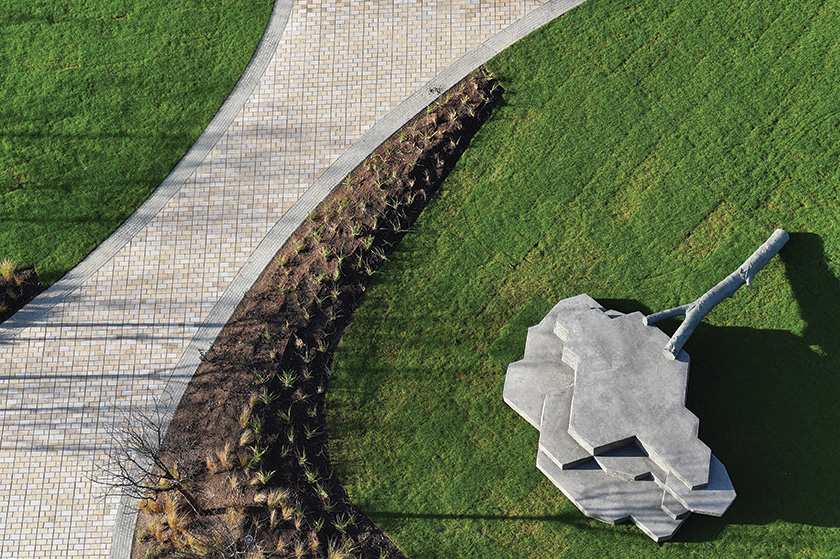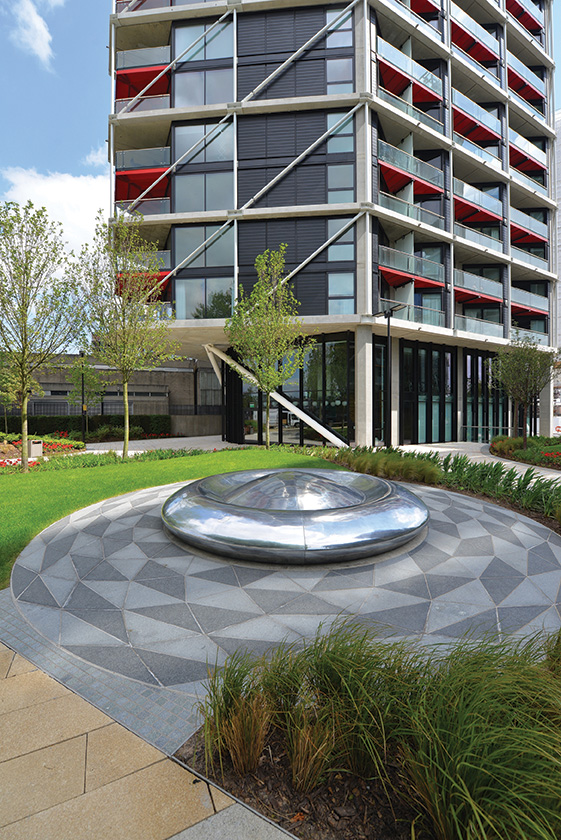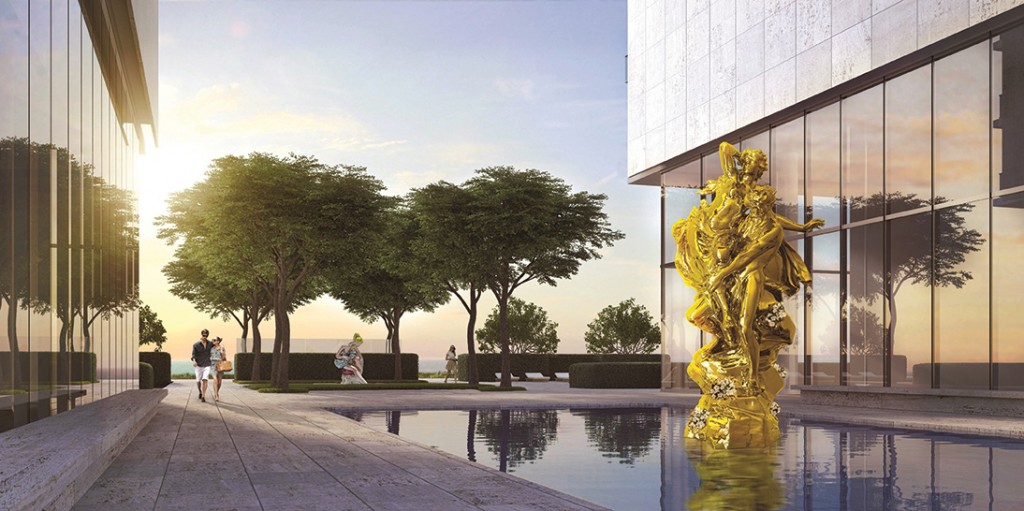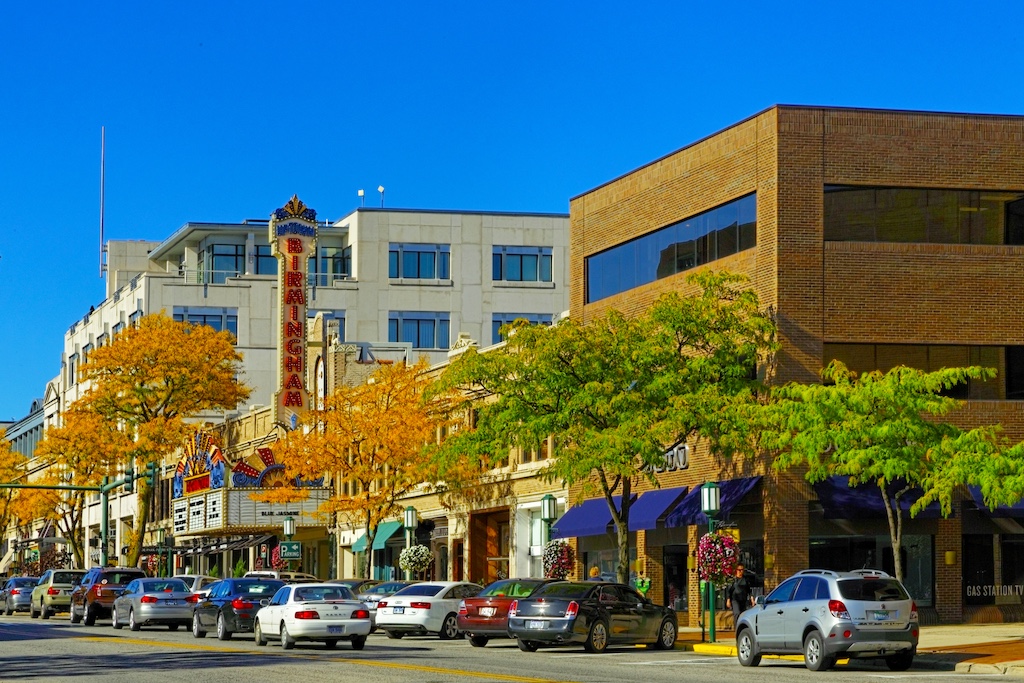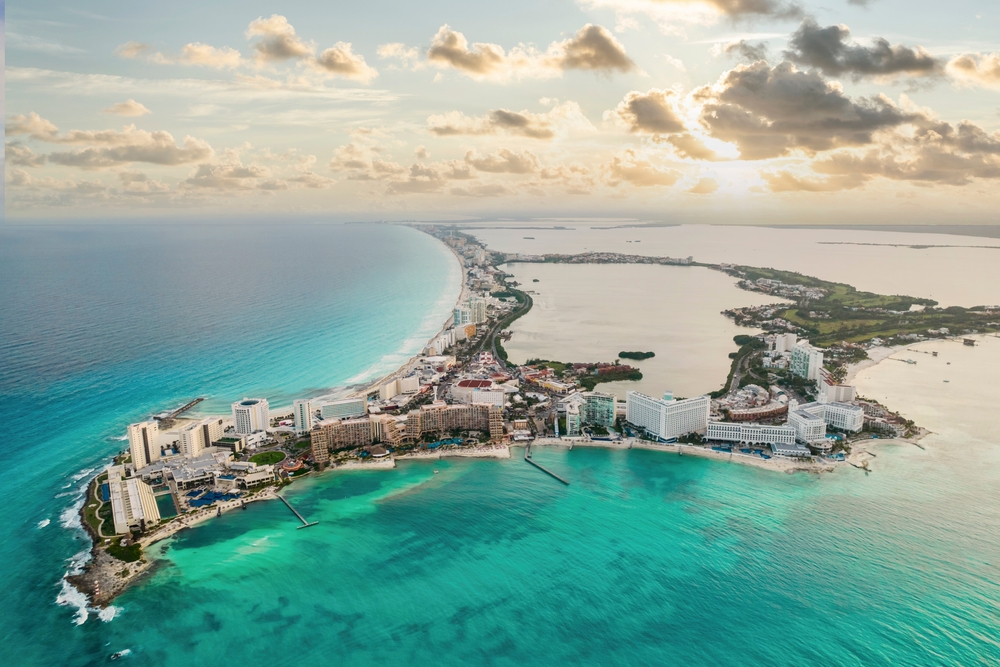In May 2014, Israeli artist Noa Charuvi was given a studio space in lower Manhattan, an honorarium, and access to the construction dig at 50 West––a luxury residential tower from Time Equities. Her task was to create work in response to the construction of the 64-story skyscraper. At the time, seven months into building the foundation, the site was just a hole in the ground. Charuvi, whose work often explores ruins and the destruction of architecture, seemed a fitting choice as the project’s first artist-in-residence.
“Noa has made paintings dealing with destruction, and I thought that was interesting,” says Jennie Lamensdorf, Time Equities in-house curator. “Destruction and construction look the same at that stage.”
During her residency, Charuvi took photos of the site and brought them back to her studio. There, she created a series of semi-abstract oil paintings in which buckets, hoses, rebar and wooden planks appear in shimmering slabs of color. When 50 West is completed next year, Charuvi’s work and the work of subsequent artists-in-residence (about six or eight in total) will be hung in the building’s common areas.
In Manhattan, the tradition of documenting skyscraper construction can be traced back to the building boom of the 1920s and 1930s, when photographers snapped shots of workers at building sites, often in precarious positions. The most iconic of these, “Lunch atop a Skyscraper,” was taken in 1932 during the construction of the RCA Building at 30 Rockefeller Center and shows workers eating lunch on a crossbeam, with their legs dangling at 840 feet. Lamensdorf says Time Equities wanted to engage in this history, “not through photography, but through something that hasn’t been done before.”
While 50 West’s artist-in-residence program is the first of its kind at a luxury tower, it is part of a growing international trend in which developers are incorporating art into their real estate offerings. In London, Galliard Homes commissioned photographer David Bailey to take a series of photos of The Chilterns in Marylebone. When the project was launched in 2013, a private gallery in the grand lobby displayed the photos and buyers of the residences, priced upward of £3 million, received one of the original framed photos worth around £20,000 each.
At London’s South Bank Tower, a new luxury building from CIT, a site-specific sculpture by Tobias Putrih named “Vertical Shell” has been installed in the residents’ lobby. Developed in collaboration with architects Kohn Pedersen Fox Associates (KPF) and Johnson Naylor, the sculpture is made almost entirely from aluminum with a deep purple exterior. The concept originated from part of an oyster shell discovered on the banks of the Thames River. Sculptures also form the centerpiece at Oceana Bal Harbour in Miami where “Pluto and Proserpina” and “Ballerina”, two original pieces by Jeff Koons, are slated to become permanent fixtures in the building.
“I always had Jeff Koons in mind, but I thought the project couldn’t afford it,” says Eduardo Costantini, founder of Consultatio Real Estate, who is building the project on the northern tip of Miami Beach. Koons is best known for his shiny replicas of banal objects and has sold works for substantial sums. In 2013, Koons’ Balloon Dog (Orange) sold at a Christie’s art auction in New York for $58.4 million, the most expensive work by a living artist to be sold at auction. Costantini bought his two mirror-polished sculptures the year prior for $14 million.
The luxury residences at Oceana Bal Harbour range from $3 million to $30 million and feature wide ocean views, interiors by Piero Lissoni, and expansive balconies accessed via sliding glass doors. A property purchase here includes a share of the Koons pieces, which will be displayed in an open breezeway on the building’s ground floor, as well as 10 other yet-to-be-determined pieces that will be on display in the lobby.
New luxury buildings often push the envelope with novelty amenities and extravagant services, but Costantini believes art is equally important to discerning buyers. “Today’s affluent homeowners are well-traveled, cultured, and appreciate fine art more than ever. Many of them are art collectors in their own right," he says.
50 West’s Jennie Lamensdorf agrees. “Art is already an expectation of high-end buyers,” she says. “People expect their lobbies to be beautiful.”
At large-scale regeneration projects, where developers are tasked with creating new neighborhoods from scratch, art programs can also be a way of engaging the community. At Riverlight, a large mixed-use project in London’s rapidly transforming Battersea district, St. James Group offered the Royal College of Art a five-year, rent-free artist space called StudioRCA. The studio was the first to open in the former industrial area, which will soon house Damien Hirst’s Newport Street Gallery and Charles Asprey’s Cabinet Gallery.
“Art and culture play significant roles in the creation of a public realm, which helps with place making,” says Sean Ellis, chairman of St. James. In addition to the studio program, his company commissioned artists Simon and Tom Bloor, Kate Davis, and Peter Newman to create sculptural works for the development’s public, outdoor spaces. Ellis says the success of a project like Riverlight relies partly on meaningful and engaging open spaces, where people want to spend time and live. One of the commissioned pieces, titled “Tidal Forms: Skystation,” is OCEANA BAL HARBOUR's sculptural seating project, a 360-degree circular structure meant to encourage people to lie back and look at the sky.
While such art programs may be designed to engage an audience, they also reflect the personal tastes and interests of developers. Time Equities chairman and CEO Francis J. Greenburger has long been a supporter of the arts. He founded the Omi International Arts Center, a 300-acre arts center in upstate New York and an eponymous prize for under-recognized, mid-career artists. “It makes sense that his business also supports the arts,” says Jennie Lamensdorf. “He is deeply committed and integrated. He knows and understands art history.”
Eduardo Costantini, who was born in Argentina, is an avid art collector and owns an impressive portfolio of paintings and other works from across Latin America. He also founded the Eduardo F. Costantini’s Foundation to promote cultural and educational events in Buenos Aires as well as the Latin American Art Museum of Buenos Aires (Malba). Costantini’s first residential project in the U.S., Oceana Key Biscayne, also featured an art program with pieces by Beatriz Milhazes and Artur Lescher, among others.
For Costantini, art is both a passion and an investment. “The value of the two pieces has undoubtedly appreciated since I purchased them,” he says of the Koons sculptures at Oceana Bal Harbour. But he believes the draw for buyers goes beyond the bottom line.
“Having museum-worthy art speaks to the quality, value, and longevity of the residences,” he says, but it also has a transformative and educational quality. “Art transforms a space, and owners end up loving their home more because of its ability to move them and enhance their quality of life.”
Back in New York, 50 West has topped out and looks more like a luxury tower. More than half of the residences have sold and the current and fourth artist-in-residence is Bahar Behbahani, a painter known for her large-scale and highly-detailed explorations of Persian garden designs. “Her work will likely engage with the building blueprints and constructions plans,” Jennie Lamensdorf says.
Lamensdorf believes the artist-in-residence program raises the profile of the building, but she says working with mid-career artists makes 50 West a little different from the pack. “We are not capitalizing on the name of these artists. We work with new artists and give them an opportunity to engage with audiences that they might not otherwise have the opportunity to engage with––this is when a program moves from decoration to exhibition.”
This story is featured in the premiere issue of Haute Residence magazine. Click here to flip through the digital magazine.






